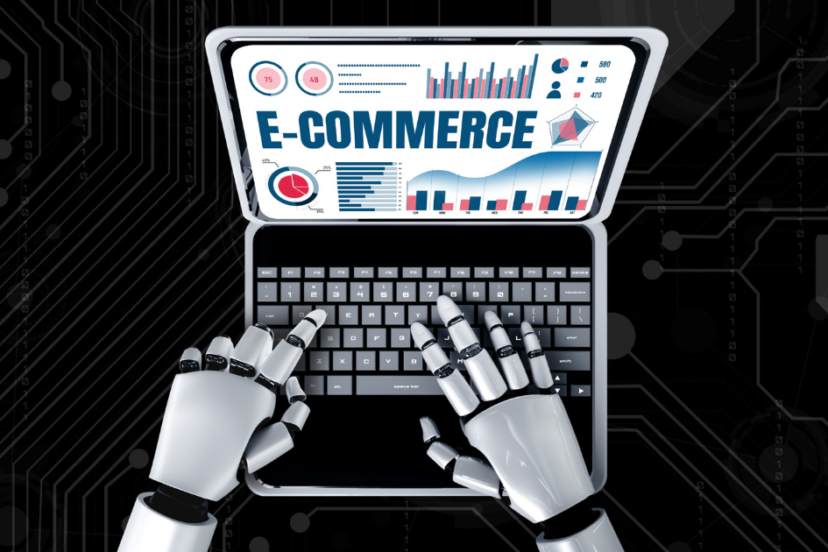How AI Analytics Can Transform Your E-commerce Strategy
Welcome to the digital age, where data is gold and competition in the e-commerce world is fiercer than ever before. In this blog, we’re diving headfirst into a game-changing technology reshaping how businesses operate online: AI analytics.
Imagine having a crystal ball that can predict what your customers want even before they do or a tool that supercharges your marketing efforts with surgical precision. That’s what AI analytics brings to the table, and we’re here to guide you through it all.
So, fasten your seatbelt, whether you appreciate tech updates or a business owner seeking practical insights. We’re about to embark on a journey and show you how it can transform your e-commerce strategy from ordinary to extraordinary. Ready? Let’s dive in!
Understanding AI Analytics
In the fast-paced world of e-commerce, staying competitive means staying ahead of the curve. AI analytics is not just a tool but a transformative force. It’s the secret sauce behind the success stories of Amazon, Alibaba, and other e-commerce giants.
Let’s start with the basics before applying it. AI and machine learning algorithms to analyze data and gain insights. Beyond typical analytics, it finds complicated patterns, trends, and anomalies that people cannot.
AI and machine learning capabilities to analyze data in unprecedented ways. It’s not just about numbers. It’s about deciphering detailed patterns, forecasting future trends, and making decisions that were only possible in science fiction.
That is the promise of AI analytics, which has the potential to reshape the e-commerce industry as we know it.
How AI Analytics Transforms E-commerce Strategy
It is pivotal in enhancing e-commerce strategies in numerous ways, providing online businesses with valuable insights and capabilities that can significantly impact their success. Here are some of the key benefits of integrating this into e-commerce strategies:
Personalized Customer Experiences:
AI can analyze huge customer data to personalize shopping experiences. By understanding individual preferences and behaviors, e-commerce platforms can recommend products, tailor marketing messages, and customize website layouts for each visitor, ultimately increasing conversion rates and customer loyalty.
Improved Product Recommendations:
AI-powered recommendation engines can suggest relevant products to customers, increasing the likelihood of cross-selling and upselling. These algorithms continuously learn from customer interactions, optimizing recommendations over time.
Inventory Management:
AI can help e-commerce businesses optimize their inventory levels. AI can minimize overstocking and understocking issues by forecasting demand, tracking trends, and identifying slow-moving items, reducing carrying costs and increasing profitability.
Dynamic Pricing:
E-commerce businesses can use AI to dynamically adjust product prices based on real-time market conditions, competitor pricing, and customer demand. This ensures competitive pricing strategies and maximizes revenue.
Fraud Detection:
AI-powered fraud detection systems can evaluate transaction data in real time to avoid payment fraud and account takeovers. This helps protect both customers and the e-commerce platform itself.
Customer Support and Chatbots:
AI-powered chatbots can answer basic questions and resolve issues 24/7. They can also escalate complex inquiries to human agents, improving response times and customer satisfaction.
Predictive Analytics:
AI can forecast customer behavior and trends using historical data. This information can inform marketing strategies, product development, and inventory management, helping e-commerce businesses stay ahead of the competition.
Search and Navigation Optimization:
AI-powered search engines improve user experience and conversion rates by providing more accurate and relevant results. Additionally, AI can enhance website navigation by suggesting categories and filters matching user preferences.
Customer Segmentation:
Customer data such as demographics, behavior, and purchase history can be used with analytics to create customer segments. This paves the way for each subset’s more specific advertising and product distribution.
A/B Testing and Optimization:
AI can automate A/B testing processes to determine which website layouts, marketing messages, and product placements are most effective at driving conversions. This iterative optimization leads to improved e-commerce strategies over time.
Supply Chain Optimization:
AI can optimize supply chain processes by predicting demand, identifying bottlenecks, and suggesting efficient routes for product delivery. This helps e-commerce businesses reduce operational costs and meet customer expectations for timely delivery.
Competitive Analysis:
AI can monitor competitors’ prices, products, and marketing strategies in real-time. This information allows e-commerce businesses to adjust their plans to maintain a competitive edge.
How to get started with AI analytics for an e-commerce business?
Getting started with AI analytics for an e-commerce business can improve customer experiences, increase sales, and optimize operations. Here are five essential steps to begin your journey:
- Define Your Objectives and Goals:
Begin by explicitly identifying your goals for using AI analytics. Consider specific goals, such as increasing sales revenue, reducing operational costs, improving customer satisfaction, or enhancing inventory management. Understanding your objectives will guide your AI analytics strategy.
- Gather and Prepare Data:
High-quality data is the lifeblood of AI analytics. Gather data from sales transactions, online interactions, consumer demographics, and other sources. Ensure that the data is clean, consistent, and properly labeled. Data quality is essential for accurate AI-driven insights.
- Select Appropriate AI Tools and Technologies:
Choose AI analytics tools and technologies that align with your objectives and data. Standard AI technologies for e-commerce include machine learning algorithms for recommendation engines, natural language processing for chatbots, and predictive analytics for demand forecasting. Depending on your resources and requirements, you may opt for pre-built AI solutions or build custom models.
- Implement and Train AI Models:
Implement AI models and integrate them into your e-commerce systems. This may involve working with data scientists, machine learning engineers, or AI vendors. Ensure that your team is trained to use and maintain these models effectively. Test and improve the AI analytics solution in a pilot project before spreading it throughout your organization.
- Monitor and Iterate:
AI analytics is not a one-time implementation; it requires continuous monitoring and refinement. Track the impact of AI analytics on your e-commerce business with KPIs. Regularly review the results, gather feedback, and iterate on your AI models and strategies. As your business evolves, adjust your AI analytics initiatives accordingly.
How to Measure AI Analytics ROI
You can only evaluate the success of your AI-driven plans by first measuring the ROI of AI analytics in an e-commerce context. Here’s a step-by-step guide on how to measure AI analytics ROI:
- Define Clear Objectives: Begin by setting clear and specific objectives for your AI analytics initiatives. These objectives should be tied to key performance indicators (KPIs) such as increased revenue, reduced costs, improved customer satisfaction, or enhanced operational efficiency.
- Data Collection and Tracking: Ensure you have robust data collection mechanisms to capture relevant data before and after implementing AI analytics. This data could include sales, website traffic, customer feedback, and operational metrics.
- Benchmarking: Establish a baseline or benchmark for the key metrics you intend to measure. This represents the performance of your e-commerce business before implementing AI analytics.
- Implementation Costs: Calculate the costs associated with implementing AI analytics. This includes software and hardware expenses, personnel salaries, training costs, and other investments in AI technology.
- Post-Implementation Data Analysis: After the AI analytics system has been in operation for a sufficient period, analyze the data to measure its impact. Compare the post-implementation performance metrics to the baseline established earlier.
- Revenue Growth: Measure any increase in revenue that can be directly attributed to AI analytics. This can include higher sales from personalized recommendations, improved pricing strategies, or enhanced customer engagement.
- Cost Reduction and Operational Efficiency: Identify areas where AI analytics has led to cost reductions. This might include lower marketing costs due to improved targeting, reduced customer service expenses through chatbots, or optimized inventory management. Determine if AI analytics has improved operational efficiency, such as faster order processing, reduced manual work, or improved supply chain management.
- Customer Satisfaction: Assess changes in customer satisfaction and loyalty metrics. AI analytics often leads to better customer experiences through personalized recommendations and improved support, which can be quantified through surveys or feedback data.
- Calculate ROI: To calculate ROI, subtract the total implementation costs (step 4) from the total benefits gained (sum of increased revenue, cost reductions, and other measurable gains). Then divide this net benefit by the implementation cost and multiply by 100 to express it as a percentage:
ROI (%) = [(Total Benefits – Implementation Costs) / Implementation Costs] x 100
- Periodic Assessment, Analysis and Reporting: Continuously monitor and assess the ROI of your AI analytics initiatives over time. AI’s impact may evolve as your e-commerce business changes, so ongoing evaluation is essential. If multiple strategies are in play, consider conducting an attribution analysis to understand which AI analytics components drive the most ROI. Share your ROI findings with stakeholders to justify ongoing AI investments and to inform future strategy decisions.
Measuring AI analytics ROI is an ongoing process that should evolve as your e-commerce business grows and your AI initiatives mature. Your aims and business goals may evolve, making it necessary to revisit and revise your measuring strategies frequently.
Conclusion
In this exciting journey through AI analytics and e-commerce, we’ve covered a lot of ground, from understanding it’s basics to exploring its many benefits. It’s clear that AI is not just a buzzword; it’s a game-changer for your online business.
But, as with any revolutionary technology, there are challenges and responsibilities. Ethical considerations and data security should always be at the forefront of your AI journey. Remember, with great power comes great responsibility. Embrace the AI revolution! It’s not a luxury; it’s a necessity. Doing so will delight your customers, optimize your operations, and stay ahead of the competition.
Dive into the world of AI analytics and watch your e-commerce strategy transform before your eyes. It’s a journey worth embarking on, and the future of your business is waiting to be shaped by the incredible potential of AI.




